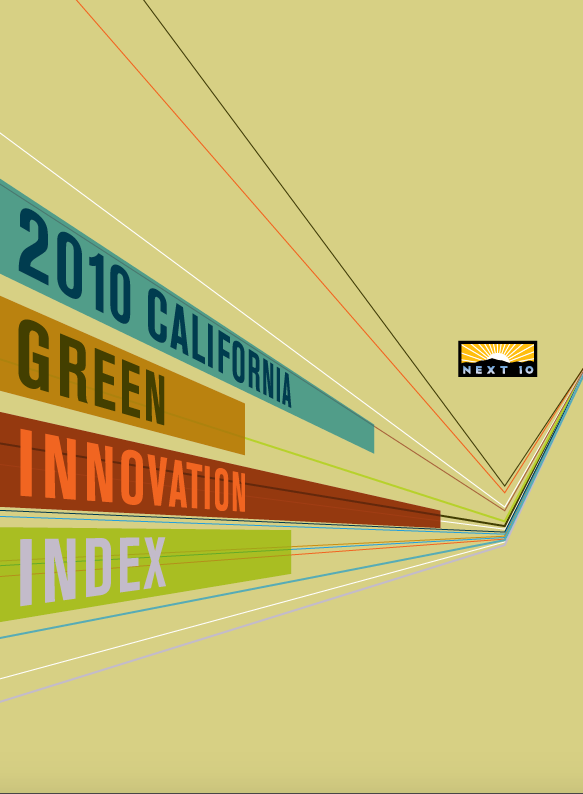Publications
2010 California Green Innovation Index
The 3rd edition of the Index documents California’s increasing global leadership in green innovation, cleantech venture capital investment, and energy productivity, despite the economic downturn. New data also show that more businesses are opening in California than are closing or leaving.
Research included in this 2010 California Green Innovation Index details that California’s global leadership in green innovation continues to grow, attracting billions in investment dollars. California’s green manufacturing jobs are growing while conventional manufacturing jobs are in decline, and California’s economy has profited from efforts to improve energy efficiency and reduce its dependence on carbon. Californians are also getting out of their cars more to use public transportation, or using more alternative fuels when driving.
This year’s Index includes two special features. The first, “The Changing Business Climate in California: Impacts & New Opportunities” examines myths about California’s business climate and found contrary to conventional wisdom, the facts are:
- Fact One: Electricity bills are lower in California.
- Fact Two: California manufacturers spend a smaller percentage of total operating costs on electricity.
- Fact Three: California’s electricity productivity in manufacturing is outpacing the rest of the nation.
- Fact Four: More businesses are starting up in California than are leaving or closing.
The second feature “Manufacturing in the Core Green Economy; Growing Opportunities Across the Value Chain” finds that California is experiencing a significant expansion in green manufacturing employment. This is occurring even while manufacturing employment overall is in decline, manufacturing businesses and jobs are found in every region of California. While overall employment numbers are still modest, they are growing at a rapid clip.
Next 10 owns the rights to this publication. Any usage of content from this publication is subject to our Terms of Use.
California's global leadership in green innovation continues to grow, attracting billions in investment dollars.
- Global VC investment in clean tech is becoming more concentrated in California. Accounting for 24 percent of global total investment, the state has attracted $11.6 billion in clean tech VC since 2006.
- In the first half of 2010, the state attracted 40 percent of global clean tech VC exceeding the first half of 2009 by 246 percent
- California is the top state in patent registrations in green technology, outpacing second-ranked New York by more than 150 patents between 2007 and 2009.
- From 2007 to 2009, California represented 39 percent of Solar Energy patents registered in the U.S., up from 24 percent in the period from 1995 to 1997. California accounts for 20 percent of all Battery Technology patents registered in the U.S. between 2007 and 2009, and 16 percent of total patent registrations.
California's green manufacturing jobs are growing while conventional manufacturing jobs are in decline.
- From 1995 to 2008, manufacturing employment in core green economy expanded by 19 percent, while there was a nine percent drop in total manufacturing employment. Between 2007 and 2008, green manufacturing employment grew by 1 percent, while total manufacturing employment dropped four percent.
- Green manufacturing is taking place in every region—with growth since 1995 in the Bay Area (+55%), Orange County (+54%), and the San Joaquin Valley (+38%).
California's economy has profited from efforts to improve energy efficiency and reduce its dependence on carbon. These gains improve the competitive advantage of the state's companies and improve the state's resiliency to external economic shocks.
- For every dollar of GDP generated in 2008, the state's economy requires 32 percent less carbon than it did in 1990, saving California residents money and giving California businesses the competitive edge.
- Overall GDP produced per unit of energy continues to be 68 percent higher than the rest of the nation and has been rising at a faster rate at least since the 1990s, freeing up billions of dollars to produce goods and services that would otherwise have been spent on energy.
- In 2007, California's manufacturers generated nearly $44 of GDP for every dollar spent on electricity—$13 more than the rest of the nation.
- From 1992 to 2007, California GDP relative to total electricity expenditures in manufacturing increased 21 percent, compared to three percent in the rest of the country.
- Between 2002 and 2007, electricity productivity of manufactures improved 13 percent in California and dropped by ten percent in the rest of the nation.
- Each Californian used 20 percent less energy in 2008 than in 1970, while energy consumption per capita in the rest of the country has generally remained above 1970 levels.
Californians are getting out of their cars more to use public transportation, or using more alternative fuels when driving.
- Public transit ridership is on the rise in California even as transit availability shrinks. The total number of annual passengers riding public transit was 16 percent higher in 2008 than 2004.
- Between 2007 and 2008, total revenue miles (a measure of transit availability) decreased 15 percent.
- Total vehicles in the state dropped by 1.3 percent from 2007 to 2008.
- Alternative fuel use is on the rise, jumping nine percent from 2006 to 2007, while conventional fuel use dropped 0.4 percent. Over the longer-term (2003-2007), alternative fuel use increased 55 percent, while conventional fuel use increased four percent.
- From 2007 to 2008, total vehicle miles (VMT) driven dropped 1.4 percent, the largest drop since 1995. Per capita VMT fell 2.8 percent over the same period.
